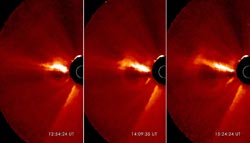New Sunspots Producing Space Weather

This triptych shows a coronal mass ejection or CME as it burst off of the sun in the morning of Jan. 13, 2013. The images were captured by NASA's Solar Terrestrial Relations Observatory (STEREO). Credit: NASA/STEREO <br>
Experimental NASA research models, based on observations from the Solar Terrestrial Relations Observatory (STEREO) and the ESA/NASA mission the Solar and Heliospheric Observatory, show that the CME left the sun at speeds of 275 miles per second. This is a fairly typical speed for CMEs, though much slower than the fastest ones, which can be almost ten times that speed.
When Earth-directed, CMEs can cause a space weather phenomenon called a geomagnetic storm, which occurs when they successfully connect up with the outside of the Earth's magnetic envelope, the magnetosphere, for an extended period of time. In the past, CMEs of this speed have not caused substantial geomagnetic storms. They have caused auroras near the poles but are unlikely to affect electrical systems on Earth or interfere with GPS or satellite-based communications systems.
Two active regions — named AR 11652 and AR 11654 by the National Oceanic and Atmospheric Administration (NOAA) – have produced four low-level M-class flares since Jan. 11. Solar flares are powerful bursts of light and radiation. Harmful radiation from a flare cannot pass through Earth's atmosphere to physically affect humans on the ground, however, when intense enough, they can disturb the atmosphere in the layer where GPS and communications signals travel. M-class flares are the weakest flares that can still cause some space weather effects near Earth. The recent flares caused weak radio blackouts and their effects have already subsided.
NOAA's Space Weather Prediction Center (http://swpc.noaa.gov) is the United States Government official source for space weather forecasts.
Updates will be provided if needed.
What is a CME?
For answers to this and other space weather questions, please visit the Spaceweather Frequently Asked Questions page.
Karen C. Fox
NASA's Goddard Space Flight Center, Greenbelt, Md.
Media Contact
All latest news from the category: Physics and Astronomy
This area deals with the fundamental laws and building blocks of nature and how they interact, the properties and the behavior of matter, and research into space and time and their structures.
innovations-report provides in-depth reports and articles on subjects such as astrophysics, laser technologies, nuclear, quantum, particle and solid-state physics, nanotechnologies, planetary research and findings (Mars, Venus) and developments related to the Hubble Telescope.
Newest articles

Security vulnerability in browser interface
… allows computer access via graphics card. Researchers at Graz University of Technology were successful with three different side-channel attacks on graphics cards via the WebGPU browser interface. The attacks…

A closer look at mechanochemistry
Ferdi Schüth and his team at the Max Planck Institut für Kohlenforschung in Mülheim/Germany have been studying the phenomena of mechanochemistry for several years. But what actually happens at the…

Severe Vulnerabilities Discovered in Software to Protect Internet Routing
A research team from the National Research Center for Applied Cybersecurity ATHENE led by Prof. Dr. Haya Schulmann has uncovered 18 vulnerabilities in crucial software components of Resource Public Key…





















